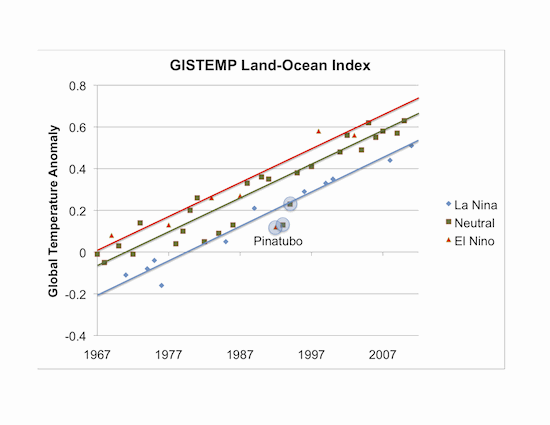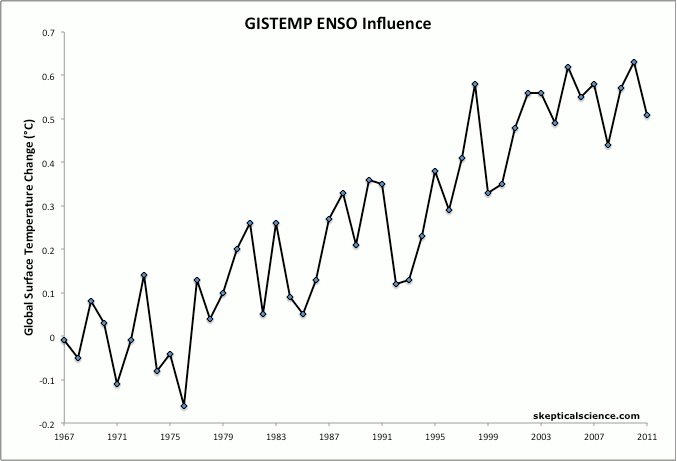John Nielsen-Gammon Comments on Continued Global Warming
Posted on 1 May 2012 by dana1981
John Nielsen-Gammon, Texas State Climatologist and a Professor of Atmospheric Sciences at Texas A&M University, has a nice article published in the Houston Chronicle regarding the misconception that global warming has stopped based on global surface temperatures.
"It’s common knowledge among those who follow such things that global temperatures have not gone up very much in the past several years. This has caused many to believe that the recent lack of warming contradicts what climate models say should happen in response to the increasing Tyndall gases. This, in turn, has provoked the counterargument that the Earth is still warming, just on a longer time scale, or that the recent period is too short to yield statistically significant results."
Nielsen-Gammon goes on to perform a simple analysis of the global surface temperature data, categorizing each year as an El Niño, La Niña, or El Niño Southern Oscillation (ENSO)-neutral year.
"I decided to take a simple approach at looking at the effect of ENSO. Using GISTemp Land/Ocean Index values and Niño 3.4 values, I computed 12-month running averages of Niño 3.4 and compared them to the average GISTemp values at lags of 0, 3, and 6 months. Foster and [Rahmstorf] used a [different] ENSO index and found optimal lags between 2 and 5 months. So one would guess that a 3-month lag would fit the data best in my case, and indeed it did.
The normal threshold for El Niño or La Niña, as applied by the Climate Prediction Center, is for five consecutive months of at least 0.5 C above or below normal in a key region of the tropical Pacific. For working with annual data, I decided to call an annual average above 0.5 C an El Niño and an annual average below -0.5 C a La Niña. Then I plotted it up, color-coding each year for whether it was El Niño, La Niña, or neither (neutral). Here’s the result:"
In this figure, Nielsen-Gammon has added linear trend lines to each ENSO category, and he notes that they all correspond to warming trends of about 0.16°C per decade. Additionally, the recent ENSO neutral years have more or less followed the ENSO neutral warming trend line, as has been the case for recent El Niño and La Niña years.
We took a very similar approach, but used the Multivariate ENSO Index (MEI) instead of Niño 3.4 values. The MEI incorporates six main observed variables over the tropical Pacific: sea-level pressure, zonal and meridional components of the surface wind, sea surface temperature, surface air temperature, and total cloudiness fraction of the sky. We also used GISTEMP global annual surface temperature anomalies, and a 4-month lag between MEI and GISTEMP, consistent with the results in Foster & Rahmstorf (2011). El Niño and La Niña years were classifed as those with MEI values of greater than 0.5 and less than -0.5, respectively (which correspond to warming or cooling effects of ~0.04°C or more on the annual global surface temperature anomaly, according to Foster & Rahmstorf). An MEI with an absolute value of less than 0.5 was classifed as an ENSO-neutral year.
In this animated GIF we can see the effect of this change in perspective, starting with simple GISS global surface temperature anomalies in the first frame, adding in the layer of information regarding the ENSO influence on each data point in the second frame, and adding the linear trend for El Niño, ENSO neutral, and La Niña years in the third frame.
The results are quite similar to Nielsen-Gammon's. For the El Niño and ENSO neutral trends, we excluded the three years influenced by the El Chichón volcanic eruption (1983-1985) and the Mount Pinatubo volcanic eruption (1992-1994). As in Nielsen-Gammon's analysis, we begin ours in 1967 in order to avoid the influence of the Mount Agung volcanic eruption.
With those points excluded, all three ENSO categories have linear trends of 0.15 to 0.16°C per decade over the past 44 years. In recent years, we also see that the annual temperature anomalies in each category have closely followed their long-term linear trends, as shown by the final frame of the GIF animation above:
Nielsen-Gammon continues with his analysis:
"The spacing between the lines is a good measure of the impact of El Niño and La Niña. All else being equal, an El Niño year will average about 0.2 C warmer globally than a La Niña year. Each new La Niña year will be about as warm as an El Niño year 13 years prior.
So we see a couple of recent La Niñas have caused the recent global temperature trend to level off. But be honest: doesn’t it seem likely that, barring another major volcanic eruption, the next El Niño will cause global temperatures to break their previous record? Doesn’t it appear that whatever has caused global temperatures to rise over the past four decades is still going strong?
So about that lack of warming: Yes, it’s real. You can thank La Niña.
As for whether this means that Tyndall gases are no longer having an impact: Nice try."
We similarly find that an average El Niño year will be approximately 0.1°C warmer than an ENSO-netural, and 0.2°C warmer than a La Niña year, all else being equal. Due to the human-caused global warming trend, as Nielsen-Gammon notes, an average La Niña year now is approximately as warm as an average El Niño year was 10-15 years ago.
Over the past 13 years, based on our categorizations, there have been four La Niña events (two in the top ten strongest over the past 44 years) vs. just two El Niño years, both of which were relatively weak, with the last one happening seven years ago. So Nielsen-Gammon is correct to note that some of the slowed surface temperature warming over the past decade can be attributed to La Niña, although there have been other influences at play as well, such as human aerosol emissions. However, due to the preponderance of La Niñas, heat has been funneled to the deeper ocean layers, and is poised to come back and haunt us in future El Niño events.































 Arguments
Arguments


























 0
0  0
0






Comments